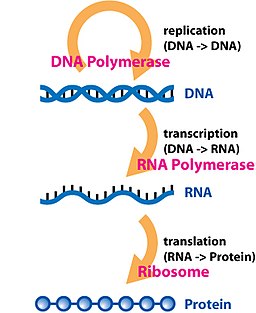Amid much discussion about potential implications for the biotech industry, a separate, extremely troubling aspect of this decision has largely slid under the radar: one of the SCOTUS Justices dissented with basic science saying he is "unable to affirm... knowledge or even my own belief" in high school biology
.

Apparently the idea of DNA → RNA → protein is too controversial for Justice Scalia.The question was whether Myriad Genetics could claim exclusive rights to two genes - BRCA1 and BRCA2 - that can determine your genetic risk for BReast CAncer. Myriad found these genes within the human genome, sequenced them, and obtained several patents that they used to prevent other companies from developing tests for the high-risk gene variants. This monopoly increased the cost of BRCA-based genetic testing, like the one Angelina Jolie recently used to discover her own genetically increased risk of BReast CAncer. So other companies and patient advocate groups sued, arguing that genes found in nature should not be patentable.
To the joy of patient advocates, SCOTUS decided 9-0 that natural genes cannot be patented - "Myriad did not create anything... it found an important and useful gene, but separating that gene from its surrounding genetic material is not an act of invention". This sounds like an easy decision, but the case involved some intricate details that required understanding of some basic biology. In particular, the court found that a naturally occurring DNA sequence can't be patented, but it upheld patents on alterations of that sequence. Many genes come with commercial breaks, known as introns, and biologists routinely remove those breaks to splice the gene back together in an uninterrupted form, which we call cDNA. cDNA, according to SCOTUS, "is not 'a product of nature' and is patent eligible".
Because the decision required basic biology, Justice Clarence Thomas began his decision where all things should begin, with an introduction. This introduction explained the basic concept that DNA holds genetic information that is transferred to RNA and then to proteins, and that some DNA has introns that are spliced out during the RNA step. This is so central to biology that it is known as "the Central Dogma".
Apparently, however, either the idea of an introduction or this basic high school biology was too controversial for Justice Antonin Scalia, who filed his own one-paragraph opinion "concurring in the judgment", but dissenting with "the fine details of molecular biology." Justice Scalia's rejection of basic science did not affect the outcome of this case, but in a world where science and technology are playing an ever-increasing role in society (see, oh, I don't know, this Supreme Court case), this dissent with the past half-century of universally accepted (in the scientific community, anyway) biology by one of the most powerful men in America is profoundly disturbing.
I join the judgment of the Court, and all of its opinion except Part I–A and some portions of the rest of the opinion going into fine details of molecular biology. I am unable to affirm those details on my own knowledge or even my own belief. It suffices for me to affirm, having studied the opinions below and the expert briefs presented here, that the portion of DNA isolated from its natural state sought to be patented is identical to that portion of the DNA in its natural state; and that complementary DNA (cDNA) is a synthetic creation not normally present in nature.Read the whole decision, including the rather well-written and scientifically accurate biological introduction here, and read about the rather odd contradictions and loopholes here.
------------------------------------------------------------------------------------
Update: Many people have suggested the interpretation that Justice Scalia was simply showing humility in admitting he did not understand the scientific background of the case. This does not add up for the following reasons:
- If Justice Scalia did not understand the facts of the case, he could and should have recused himself. He did not. He rendered a judgement regarding the legal question at hand.
- He could have simply ended with "my own knowledge", but he went on to say "or even my own belief". No one chooses their words more carefully than a Supreme Court Justice (well, poets and novelists, maybe), so we must believe he intentionally included "my own belief" to express doubt. There are no throwaway clauses in a formal Supreme Court opinion.
- The scientific introduction was not controversial, it was not questioned in the case, SCOTUS was not deciding anything about science, and the introduction of an opinion does not dictate law, neither for America nor for nature. They simply needed to understand the scientific facts of the case in order to decide how the law applies to it. Every one of the experts in the room, on both sides, would have told Scalia DNA works in the same way. Dissenting with the facts of the case is unusual, and Scalia went out of his way to do so. Commenter Chris put this rather well:
The introductory factual part of an opinion is not in any way law or controlling precedent (not even part of the noncontrollling legal discussion lawyers at times call dicta). Judges do not normally dissent from the factual part of an opinon, unless to say the majority opinion does not accurately recite the facts. Scalia's dissent has no legal importance, so appears to be politcal and his personal views. He is intending on making a statement, but what is unclear.And just to preemptively head off any big-bad liberal/conservative partisanship, remember the majority opinion was written by Justice Clarence Thomas, whom wikipedia (sorry) says "is generally viewed as the most conservative member of the Court".




Comments